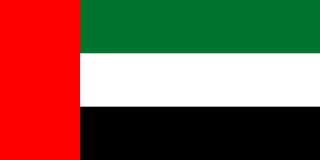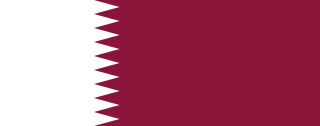Related Research Articles

Qatar is a peninsula in the east of Arabia, bordering the Persian Gulf and Saudi Arabia, in a strategic location near major petroleum and natural gas deposits. The State of Qatar occupies 11,571 km2 (4,468 sq mi) on a peninsula that extends approximately to 160 km (99 mi) north into the Persian Gulf from the Arabian Peninsula.

The United Arab Emirates is a country in the eastern part of the Arabian Peninsula located on the southeastern coast of the Persian Gulf and the northwestern coast of the Gulf of Oman. The UAE consists of seven emirates and was founded on 2 December 1971 as a federation, after UK armed forces left the region. Six of the seven emirates declared their union on 2 December 1971. The seventh, Ras al Khaimah, joined the federation on 10 February 1972. The seven sheikdoms were formerly known as the Trucial States, in reference to the truce treaties established with the British in the 19th century.

The United Arab Emirates is situated in the Middle East and West Asia, bordering the Gulf of Oman and the Persian Gulf, between Oman and Saudi Arabia; it is at a strategic location along the northern approaches to the Strait of Hormuz, a vital transit point for world crude oil. The UAE lies between 22°50′ and 26° north latitude and between 51° and 56°25′ east longitude. It shares a 19 km (12 mi) border with Qatar on the northwest, a 530 km (330 mi) border with Saudi Arabia on the west, south, and southeast, and a 450 km (280 mi) border with Oman on the southeast and northeast.

Ras Al Khaimah (RAK) is the northernmost of the seven emirates that make up the United Arab Emirates. The city of Ras Al Khaimah, abbreviated to RAK or RAK City, is the capital of the emirate and home to most of the emirate's residents. It is linked to the Islamic trading port of Julfar. Its name in English means "headland of the tent". The emirate borders Oman's exclave of Musandam, and occupies part of the same peninsula. It covers an area of 2,486 km2 (960 sq mi) and has 64 km (40 mi) of beach coastline. As of 2023, the emirate had a population of about 400,000.

The flag of the United Arab Emirates contains the Pan-Arab colors red, green, white, and black. It was designed in 1971 by Abdullah Mohammed Al Maainah, who was 19 years old at that time, and was adopted on 2 December 1971 after winning a nationwide flag design contest. The main theme of the flag's four colors is the sovereignty and unity of the Arab states.
The Omani territory of Madha or Wādī Madḥāʾ is an exclave of the Musandam Governorate, enclaved by the United Arab Emirates (UAE); inside it, there is a second-order enclave: Nahwa, which is part of the UAE Emirate of Sharjah. Madha is located halfway between the Musandam Peninsula and the rest of Oman.

The music of Qatar is based on sea folk poetry, song and dance. The historical importance of pearl fishing have deeply resonated within the region's artistic expression, manifesting in melodies, tunes, and dances that reflect the enduring bond between humanity and the sea. Traditional dances in Doha are performed on Friday afternoons; one such dance is the Ardah, a stylized martial dance performed by two rows of dancers who are accompanied by an array of percussion instruments, including al-ras, mirwas and cymbals with small drums. Other folk instruments include the oud and rebaba, both string instruments, as well as the ney and sirttai, which are types of flutes.
The Oman national football team represents Oman in men's international football and is controlled by the Oman Football Association.

Raʾs al-Ḥadd is a village in Ash Sharqiyah district in Oman. It is on a point at the entrance to the Gulf of Oman.

The yowlah, is a weapon dance of the United Arab Emirates, traditionally performed during weddings, celebrations, and other events. The dance is accompanied by traditional music, and men and women are represented in separate groups of dancers. The yowlah originated as a Bedouin war dance where men would spin rifles after victory in a battle. There is also a variation from the standard yowlah known as the razfah ; and the ardah is sometimes considered a form of the yowlah.
The Dolphin Gas Project is the natural gas project of Qatar, the United Arab Emirates, and Oman. It is the Gulf Cooperation Council's first cross-border refined gas transmission project and the largest energy-related venture ever undertaken in the region.

The culture of the United Arab Emirates is part of the culture of Eastern Arabia. Its historical population was a small tribal community that changed with the arrival of an influx of foreign nationals in the mid-20th century. Emirati culture is a blend of Arabian, Islamic, and Persian cultures, with influences from the cultures of East Africa and Indian Subcontinent. Islam has had a prominent influence on local architecture, music, attire, cuisine, and lifestyle.

The Trucial States, also known as the Trucial Coast, the Trucial Sheikhdoms, Trucial Arabia or Trucial Oman, was a group of tribal confederations to the south of the Persian Gulf whose leaders had signed protective treaties, or truces, with the United Kingdom between 1820 and 1892.

Ras Laffan Industrial City is a Qatari industrial hub located 80 kilometres (50 mi) north of Doha. It is administered by QatarEnergy.

The 2012 AFC U-19 Championship is the 37th edition of the tournament organized by the Asian Football Confederation. The AFC approved UAE as hosts of the 2012 AFC U-19 Championship on 23 November 2011. The top four teams will qualify directly to the 2013 FIFA U-20 World Cup hosted by Turkey.

Piracy in the Persian Gulf describes the naval warfare that was prevalent until the 19th century and occurred between seafaring Arabs in Eastern Arabia and the British Empire in the Persian Gulf. It was perceived as one of the primary threats to global maritime trade routes, particularly those with significance to British India and Iraq. Many of the most notable historical instances of these raids were conducted by the Al Qasimi tribe. This led to the British mounting the Persian Gulf campaign of 1809, a major maritime action launched by the Royal Navy to bombard Ras Al Khaimah, Lingeh and other Al Qasimi ports. The current ruler of Sharjah, Sultan bin Muhammad Al Qasimi argues in his book The Myth of Piracy in the Gulf that the allegations of piracy were exaggerated by the East India Company to cut off untaxed trade routes between the Middle East and India.

Ras Matbakh is a settlement in Qatar located in the municipality of Al Khor. It consists of a cape extending into the Persian Gulf. Large concentrations of mangroves are located off its coast.
References
- ↑ "الموسيقى والرقص في قطر" [Music and Dance in Qatar] (in Arabic). 5 July 2023. Retrieved 23 January 2024.
- ↑ "UNESCO - Al-Ayyala, a traditional performing art of the Sultanate of Oman and the United Arab Emirates". UNESCO . Retrieved 23 January 2024.
- ↑ "The lone drum maker of Fujairah". Gulf News . 27 December 2007. Retrieved 23 January 2024.